book review
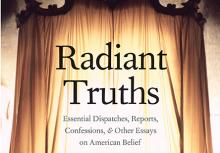
JEFF SHARLET, author of nonfiction books about faith including New York Times best-seller The Family and Sweet Heaven When I Die, isn’t so much interested in religion as he is in belief. “That interest sometimes leads me to people who might reject the term religion altogether,” he writes of drinking whiskey with Mormons and marching in Spain with Jewish-American veterans of the Abraham Lincoln Brigade, a volunteer group of up to 40,000 men and women from 52 countries who traveled to fight fascism in the Spanish Civil War.
In his newest book, Radiant Truths, Sharlet collects stories like these, stories about what happens when religious ideas meet social practice. He attributes this concept to anthropologist Angela Zito. In her essay “Religion is Media,” Zito ponders, “What does the term ‘religion,’ when actually used by people, out loud, authorizein the production of social life?” Using Zito’s question as a jumping off point, Sharlet dives into 150 years’ worth of literary journalism at the intersection of religion, culture, and politics.
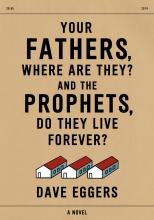
I’M IN THAT cohort of earnest, educated, now-middle-aged North Americans who fell in love with Dave Eggers’ sprawling, sometimes unapologetically self-indulgent memoir A Heartbreaking Work of Staggering Genius. All my life I had lived with an ongoing inner monologue of exaggerated self-consciousness, but I’d never read anyone who could articulate the experience as precisely, never mind playfully, as Eggers.
Eggers could have made a fortune repeating the same entertaining self-indulgence, but he’s shaped his career into anything but navel-gazing. He’s formed writing workshops for kids; started two long-running magazines; cofounded an oral history book series on human rights crises; and written a string of beautiful, compassionate books of fiction and nonfiction with an unmistakably critical eye.
In his latest novel—Your Fathers, Where Are They? And The Prophets, Do They Live Forever?—Eggers uses a dialogue-only form to tell a compact story that thunders with probity and timeless, existential urgency. The main character, Thomas, a middle-aged man with psychological issues, has conversations with six different kidnap victims—an astronaut, a former member of Congress and Vietnam vet, his high-school teacher, his mother, a policeman, and a woman he meets during walks on the beach—holding them on an abandoned military base on the California coast. He doesn’t physically harm any of them; he just wants to know where everything went wrong. Why do our friends die? Why do our career dreams come to naught? Why do the mythical promises of science, democracy, education, nationalism, law, progress, and even love fail to deliver?
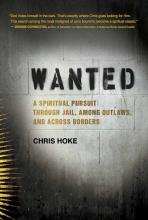
CHRIS HOKE’S Wanted isn’t a spiritual memoir in the sense of chronicling revelation over time, and while Hoke, as his own character, grows through the book, he isn’t tracking the movements of his own soul. Wanted recounts the moments in Hoke’s life as a pastor and friend to prisoners, migrant workers, and gang members when something else broke in. Whether or not it intends to, Wanted is a way of answering the question that plagues a lot of contemporary spiritual writing: What does spiritual mean, anyway? Outside the religious patterns we already know, how would we recognize it?
Hoke goes looking, and finds himself drawn to a jail in Washington’s Skagit Valley as an unofficial chaplain, leading Bible studies and hanging out with the men who soon request his visits. Many of them listen to the stories where Jesus dines with the people society rejected and ask if that could mean them too.
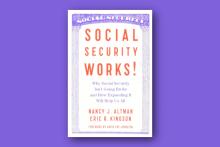
WITH A LONG history of involvement in the evolution of the Social Security program, Nancy Altman and Eric Kingson are the right analysts to explain the program and demonstrate conclusively that, with careful tending by Congress, Social Security will be there for future generations: a critical part of retirement finances for the vast majority of the American people and, for many, the only retirement support. They argue that Congress should be strengthening and expanding Social Security—and they show how this can be done and the bill paid.
The book makes clear that Social Security is not an entitlement program but a social insurance program with premiums paid through payroll taxes. Its $2.8 trillion trust fund represents the full-faith support of the American people to provide essential insurance coverage for all our people against the universal hazards of death, disability, and old age. It compares how our system stacks up against those of other advanced industrial societies. (We are distinctly less generous to our senior citizens than other developed nations.)
REBECCA TODD PETERS offers here a concise treatment of the major moral concern of a large part of Christian social ethics: the structures of globalized economic life and their manifest injustices and unsustainability. She also offers a moral framework to guide the thinking of unjustly, and often blindly, privileged First World Christians about the moral situation in which we find ourselves.
She proposes concrete action guides for how such First World Christians can gradually and intentionally empty ourselves of these privileges in order to stand in solidarity with those whose lives are harmed in the delivery of our advantages. In the end what emerges is a kind of liberation ethics for those who didn’t know they needed to be liberated—in this case, from their own advantages.

IN A RECENT interview, Wendell Berry reiterated how perplexed he was that many Christians who are guided by a deep love for God can participate so willingly in an economy that is rapidly devastating God’s creation. In his new book One Nation Under God: How Corporate America Invented Christian America, Princeton historian Kevin Kruse offers a narrative that sheds light on how our churches got into the mess that Berry bemoans. As the book’s subtitle indicates, the primary story that Kruse traces is that of the genesis of “Christian America,” which unfolded not in the era of the Founding Fathers, as David Barton and other conservative Christians contend, but rather in the mid-20th century with industrialists who rallied churches to oppose FDR’s New Deal.

“WE ARE AT the moment when our lives must be placed on the line if our nation is to survive its own folly.”
Martin Luther King Jr. gave this stinging critique of the apathetic nature of both the U.S. church and the general public more than 40 years ago. While some things have changed for the better, the truth remains that the three evils of society that King named (racism, militarism, materialism) continue to pervade U.S. culture, crippling our moral and ethical foundation.
It is difficult to imagine that someone the FBI once labeled as “the most dangerous man in America” would one day have his own national holiday. Each year we celebrate the life of King with an incomplete and romanticized retelling of the impact he had on society during and after the civil rights movement. He dreamed of a better nation, but what was it about his dream that made him a nightmare to the U.S. government?
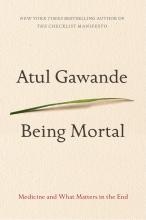
EARLY IN Being Mortal, surgeon Atul Gawande tells the story of Joseph Lazaroff, a patient with incurable prostate cancer. His medical team pursued multiple treatments, including emergency radiation and surgery, but Lazaroff ultimately died. What most struck Gawande later was that he and the team avoided talking honestly about Lazaroff’s choices—even when they knew he couldn’t be cured.
“We could never bring ourselves to discuss the larger truth about his condition or the ultimate limits of our capabilities, let alone what might matter most to him as he neared the end of his life,” Gawande writes. “The chances that he could return to anything like the life he had even a few weeks earlier were zero. But admitting this and helping him cope with it seemed beyond us.”
Why is that? For one, Gawande’s medical training didn’t prepare him for dealing with frailty, aging, or dying, he writes. He and his peers were taught to “fix,” to heal people with expertise, tools, and tests. Like most doctors, he approached his patients’ challenges as medical problems to solve, whether they were the accumulations of old age or terminal illness.


WE LIVE IN an age of deep fragmentation. Like the ancient Gnostics, who believed in a deep divide between mind and body, we too are inclined to elevate the mind, or the spirit, over the body. The critic Harold Bloom once suggested that the religious practice of most Americans is “closer to ancient Gnostics than to early Christians.”
Ragan Sutterfield’s new memoir, This is My Body: From Obesity to Ironman, My Journey into the True Meaning of Flesh, Spirit, and Deeper Faith, recounts the story of his own struggles amid the fragmentation of our times. Having wrestled with being overweight since his childhood, Sutterfield eventually finds himself with a failing marriage and at his heaviest weight. He is faced with the incongruity that he is an environmentalist and farmer, doing grueling work to care for the land and creation, and yet taking poor care of his own body.
This is My Body is a compelling story of conversion, not unlike St. Augustine’s Confessions, as Sutterfield finds himself drawn out of the typical U.S. sort of Christianity that has little regard for the body and into a deeper faith in Christ, in which spirit and body are deeply interwoven. After the collapse of his first marriage, Sutterfield surrenders himself to the disciplines needed to care better for his body, specifically controlling his diet and becoming serious about exercise. From this conversion point onward, Sutterfield begins to learn and experience an incarnational faith in which our bodies cannot be taken for granted. He writes:
What if God ... became flesh and remains enfleshed? What if God not only has a heart that longs for our love but also a heart that pounds with blood? What if God has skin that drips with sweat? What if the God who offered his body as a sign of love also wants us to experience our bodies as a gift of ... love? Christians must worship a God who is all of these things because we worship a God who was made manifest to us in the human, embodied life of Jesus.
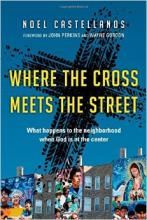
NOEL CASTELLANOS is the CEO of the Christian Community Development Association, a network of Christians committed to seeing people and communities restored spiritually, economically, physically, and mentally. In order to nurture that holistic work, committed CCDA practitioners move into under-resourced neighborhoods and try to foster community. Castellanos’ experience with CCDA and a lifetime of missional community has informed his new book, Where the Cross Meets the Street: What Happens to the Neighborhood When God Is at the Center (IVP Books), a powerful testament to the necessity of externally focused ministry. He was interviewed via email by Dave Baker, who is responsible for school accounts and diversity initiatives at Baker Book House.
Dave Baker: You write that in terms of diversity, the evangelical community is far behind the rest of society. In what ways?
Noel Castellanos: Most evangelical denominations and organizations are not very ethnically or culturally diverse in leadership. With the amazing demographic changes that are happening in our country, how can we possibly be in a position to effectively reach and disciple people of color if the leadership on boards and in executive positions is all white?
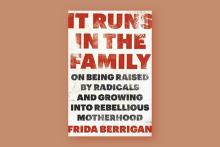
SOME PEOPLE (I was one) will initially read this book to learn what it was like for the author to grow up in Jonah House, a faith-based community of peacemakers in Baltimore, with internationally known activist parents Phil Berrigan and Liz McAlister providing strong ballast when not spending time in prison for nonviolent civil disobedience. I wanted to know what formed the vibrant Frida Berrigan, with whom I work on the National Committee of the War Resisters League. I learned about Frida’s birth in a basement, about Jonah House folks reading the Bible before days of work as house painters or being arrested at protests, about Frida and her sibs watching television on the sly, about the nitty-gritty of dumpster-diving at Jessup Wholesale Market.
But I learned much more from It Runs in the Family, and the “more” is at the heart of this fascinating book, which blends memoir, parenting advice, and connections between the questions parents ask about their children and the questions we should ask about the world. Phil Berrigan and Liz McAlister taught their children about the woes and warfare of the world; in this book, Frida also gently teaches us, while describing both her life as a child and her life as a mother to Seamus, Madeline, and stepdaughter Rosena.
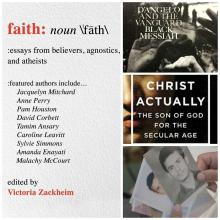
Soulful Protest
R&B singer D’Angelo ends a 14-year hiatus with the album Black Messiah, on which he sings of prayer, love lost, climate change, race, and violence. He asks, “In a world where we all circle the fiery sun / with a need for love / what have we become?” RCA
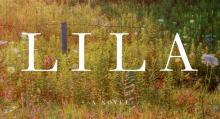
MARILYNNE ROBINSON’S Lila is the love story we thought we already knew, but didn’t. Lila takes us back to Gilead, Iowa, the same setting as Robinson’s novels Gilead and Home, describing the backstory and courtship of old Rev. Ames and the much younger Lila from a completely new point of view.
In Gilead, Ames describes his immediate, unlikely love for Lila, the hard-working wanderer. But Ames’ description of the feeling of love is more vivid than his description of the woman he loves.
The reverse is true in Lila. We learn Lila’s story through thick third-person prose. Robinson’s narration often reflects Lila’s stream of consciousness—a scattered, questioning pattern of thought, apt for a woman digesting the idea of small-town permanency after an exciting, scary, shame-filled life on the road. In the novel’s opening scene, Lila is just a small child, neglected and dying on the front steps of her house. Doll, a loving and hardened itinerant, kidnaps her just in time. It’s unclear if Doll stole or saved Lila. We can’t ever be sure. Either way, her love for Lila is fierce, and Lila comes to depend on it as they travel around the country, living off of door-to-door labor and inside jokes.
LEONARDO BOFF’S Francis of Rome and Francis of Assisi: A New Springtime for the Church offers intriguing portraits of the current bishop of Rome and the saint that is his namesake. The book provides an introduction to these two extraordinary figures and includes a brief overview of the papacy, tracing how the office of the bishop of Rome eventually became the infallible pope.
The Roman Catholic Church depicted through Boff’s eyes is a church in crisis, reeling from the Vatican Bank and clergy sex abuse scandals. The institution and leadership have lost credibility in the eyes of many and the Roman curia is in need of reform. Yet this crisis is tempered by the election of Jorge Mario Bergoglio as pope, which for Boff fuels a tangible optimism for the church’s future.
Both men in these pages are called to the work of reform. Francis of Assisi’s conversion began when he heard a crucifix in a small church say, “Francis, go and restore my house, because it is in ruins.” Boff depicts Pope Francis as receiving a similar call, to reform the church so that it becomes a church that is poor, emphasizing humility and charity. Boff raises both men as models of living with the poor and like the poor, citing the now famous example of Francis going to pay his hotel bill after being elected pope.

Living God's Reign
In Witnessing: Prophecy, Politics, and Wisdom, edited by Maria Clara Bingemer and Peter Casarella, international scholars write on many aspects of Christian witness, including martyrdom (especially Catholic martyrs in El Salvador), personal narrative, the interlocking realities of God’s beauty and justice, and intercultural dialogue. Orbis
USERS OF MAPS—that’s all of us—may suppose that what we see is factual, accurate, bias-free. Of course location, distance, elevation, and comparative importance are reliably shown!
Not so fast, says social activist and pastor Ward L. Kaiser. A map may be “right” in some ways but still dangerous to the way we live in the world.
Why? Because maps are layered with meaning. Surprisingly, their most important messages may lie beneath the surface. In his full-color book How Maps Change Things, Kaiser helps the reader to dig in and discover some of those hidden, mind-bending messages.
As a college chaplain I am acutely, sometimes painfully, aware of the often-hidden narratives and symbols that define us as individuals and as a culture. This book has helped me analyze how maps—an increasingly pervasive form of symbolic messaging and storytelling in our time—connect us to power and privilege or consign us to society’s also-rans.
PREACHERS, politicians, and other public speakers know that a story is often the best way to get a point across to their listeners. In his itinerant ministry, Jesus was no exception. Some of his most important teaching was contained in stories—parables. Yet often we do not take them seriously enough to seek what he was really saying. Two thousand years of Christian theology has also obscured his original intent, often by considering them to be allegories rather than stories.
In that process, anti-Jewish stereotypes and prejudices have too often come to dominate the interpretation of the parables. Any villain is seen as representing Judaism, while the hero or victim represents the church—and, of course, in this framing God is on the side of the church. This often-unconscious bias affects how we read and understand the story and obscures Jesus’ message.
Professor Amy-Jill Levine, in Short Stories by Jesus, aims to correct that. As a Jewish New Testament scholar teaching at a Christian divinity school, she is uniquely situated to place Jesus and his teaching in their historical and cultural context. Jesus was a first-century Jew speaking to other first-century Jews. If we do not understand that starting point, we cannot understand Jesus or his stories. In an introduction not to be skipped, she points out that the parables often echo themes that appear elsewhere in Jesus’ teachings: economics, relationships, and, most important, prioritizing life in expectation of the coming kingdom of God. To make his point, he uses common, everyday examples of real-life characters and situations his audience would recognize.
IN 1973, IMMEDIATELY following the Yom Kippur War, I watched the movie Exodus. I was so swept up by Leon Uris’ depiction of the Zionist struggle that I wrote in my journal, “The U.S. should do everything it can to defend the state of Israel!”
Two years later, I read a history of the Arab-Israeli conflict in a serialized encyclopedia of World War II. It transformed me into an impassioned defender of Palestinian rights. Clearly, the historical narrative one accepts is critical to determining how a conflict is understood.
Jo Roberts’ book Contested Land, Contested Memory: Israel’s Jews and Arabs and the Ghosts of Catastrophe challenges the nationalist mythologies of both Israelis and Palestinians, peoples largely in denial of each other’s histories. With exhaustive research and numerous personal interviews, Roberts has created a book that is both sensitive to and challenging for partisans of either side.
Roberts begins with the story of an Israeli Jew whose memories of idyllic childhood vacations in a particular village are shattered when she learns from a Palestinian boyfriend that his family was displaced from that village by Israeli soldiers in 1948. Roberts goes on to offer a history of Zionism that is not without its share of heartbreak. From persecution in Catholic Spain to the Dreyfus affair in France and government-sanctioned pogroms in Russia, she reminds us of the prevalence and ferocity of anti-Semitism, which led many to join the movement to create a Jewish state in Palestine. She includes a report to President Truman about 250,000 Holocaust survivors, who in late 1945 were still confined in former slave labor and concentration camps because no country, including the U.S., would accept them as refugees. Roberts makes a convincing case that many Jews went to Palestine because they literally “had nowhere else to go.”

IN THE U.S., mention of “aging in community” might conjure up images of weathered faces in nursing homes and snowbirds in South Florida. And yet, as increasing numbers of Americans reach the golden years—and do so in an uncertain economy—so do the array of scenarios for those growing older. Award-winning journalist Beth Baker traveled across the U.S. to document the possibilities in her latest book, With a Little Help from Our Friends: Creating Community as We Grow Older.
Some of her findings aren’t so surprising. Baby boomers have a stronger desire for independence than did their predecessors, and they aren’t keen on being tagged “elderly.” In fact, they generally see themselves in a different cohort than those born just prior to the boom.
Whether you’re in one of the aforementioned age groups or a diligent millennial thinking way ahead, Baker shows that imagining how you’ll one day balance independence with human connection in your older years doesn’t have to be daunting.
“That we can raise this question is remarkable. Never before have older people, often through their own imagination and determination, had real options from which to choose,” she writes.